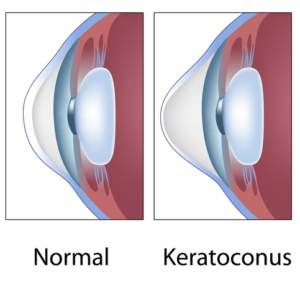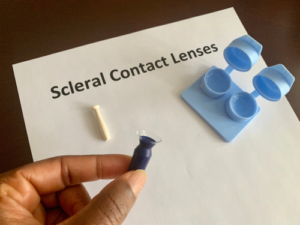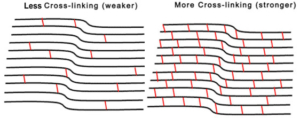Are There Treatment Options for Keratoconus?
Do you have keratoconus? You may be wondering if there are ways of treating this eye condition.
Keratoconus is a non-inflammatory condition that causes the cornea to get thinner and weaker. As a result, the cornea bulges outward into a cone shape, causing significant vision impairment.
Most people diagnosed with keratoconus are in their teenage years through their twenties. Keep reading to learn more about keratoconus and the treatment options available.
Causes of Keratoconus

Experts still don’t know the exact cause of keratoconus. But researchers believe that some people have a higher risk of developing the eye condition than others due to the following factors:

- Age
- Having a family history of keratoconus
- Chronic eye inflammation
- Excessive and vigorous eye rubbing
- A history of using poorly fitting contact lenses
- Certain systemic disorders like down syndrome, retinitis pigmentosa, and Ehlers-Danlos syndrome
Symptoms of Keratoconus
Blurred vision is a common sign of keratoconus. Other symptoms you may experience include:
- Eyestrain
- Poor night vision
- Eye pain
- Astigmatism
- Nearsightedness
- Persistent headaches
- Eye irritation
- The appearance of halos and glare around lights
- Frequent prescription changes

Keratoconus usually impacts both eyes. However, one eye may show signs earlier than the other. One eye might be more affected compared to the other.
Treatment Options for Keratoconus
How your eye doctor at Eye Consultants of North Dakota chooses to treat keratoconus will depend on the severity of your symptoms and include the following options:
Prescription Glasses and Soft Contact Lenses
Eyeglasses and soft contacts can easily correct blurry vision caused by mild keratoconus. If the severity of keratoconus varies in each eye, your eye doctor will prescribe glasses or contacts with different powers to restore your vision.
Prescription glasses can also correct nearsightedness, a common refractive error if you have keratoconus.
Rigid Gas Permeable Contact Lenses (RGP)
If you have advanced keratoconus, you might need to wear rigid gas permeable contact lenses (RGP). These contact lenses are tailored to fit over your cornea and deliver a more spherical shape.
In keratoconus, light enters your eye through the cone-shaped corneal surface, causing it to scatter. The spherical shape of rigid gas permeable contact lenses lets light refract properly through the smooth, even surface, allowing the lenses to correct your vision.
Hybrid Contact Lenses
Hybrid contact lenses combine two designs: a soft skirt with a rigid or stiff center. The soft skirt makes it easier to put in the contacts and offers extra comfort throughout the day.
Having a rigid design helps the contacts maintain their shape. What’s more, hybrid contact lenses transmit oxygen to the cornea and provide crisp, clear vision. If you’re struggling to wear soft contact lenses and you have keratoconus, you may benefit from hybrid contacts in the following ways:
- They maintain their shape better, leading to more consistent and precise vision.
- Hybrid lenses promote healthy eyes because they don’t contain water like soft contacts, so they’re less likely to encourage the growth of bacteria.
- Hybrid lenses last longer than soft contacts.
- Hybrid lenses can restore vision at different stages of keratoconus.
- They’re easier to clean and disinfect.
Scleral Contact Lenses
Scleral contact lenses come from the same material as rigid gas permeable lenses. Scleral contact lenses also have a smooth, uniform surface.

However, scleral contacts have a wider diameter than rigid gas permeable lenses. The lens forms a dome shape over the irregular cornea with scleral contact lenses, offering a new refractive surface.
Creating a new refractive surface enables light entering the eye to be in proper focus. If you have advanced keratoconus, your ophthalmologist may recommend using scleral contact lenses.
The contacts offer sharper vision and last longer than soft lenses. They also don’t lose clarity or change shape like soft contacts. Scleral lenses perform better than rigid gas permeable contacts when it comes to visual clarity, stability, and comfort.
Corneal Cross-Linking
Corneal cross-linking or CXL is a minimally invasive procedure aimed at slowing down or preventing the further progression of keratoconus. Corneal cross-linking boosts the strength of the corneal tissue to stop bulging.
Undergoing corneal cross-linking can help avoid the need for a corneal transplant later. It’s FDA-approved for patients 14 years of age and older.
The sooner you can have corneal cross-linking, the better. There are two types of corneal cross-linking procedures: epithelium-off and epithelium-on.

With epi-on corneal cross-linking, the epithelium remains intact during the procedure. But when performing epi-off corneal cross-linking, your surgeon removes the outer layer of the corneal tissue.
The outer layer of the cornea is the epithelium. After peeling off the epithelium, your ophthalmologist will apply riboflavin or vitamin B eye drops to the cornea.
Removing the epithelium allows the drops to penetrate better into the deeper layers. After applying drops, they will shine UV light to activate the riboflavin.
The unique combination of vitamin B and UV light strengthens the bond between collagen molecules in your cornea to stabilize it. It’s important to note that corneal cross-linking doesn’t restore vision loss due to keratoconus or eliminate the need for prescription glasses.
Corneal Transplant Surgery
If you have severe keratoconus and other treatment options aren’t effective, your ophthalmologist may recommend a corneal transplant. Also known as keratoplasty, a corneal transplant involves removing some or all of your cornea.
After removing the damaged cornea, Dr. Anne Keating will implant donor tissue from a healthy cornea. To ensure your transplant’s success, you may need to take medication to reduce the possibility of rejection.
Choose the Top Keratoconus Specialists

If you’re concerned you might have keratoconus, Eye Consultants of North Dakota can help. Dr. Anne Keating brings unrivaled expertise when diagnosing and treating keratoconus patients.
Find out more about keratoconus, including the best way to treat it, by scheduling your appointment at Eye Consultants of North Dakota in Fargo, ND, today!



